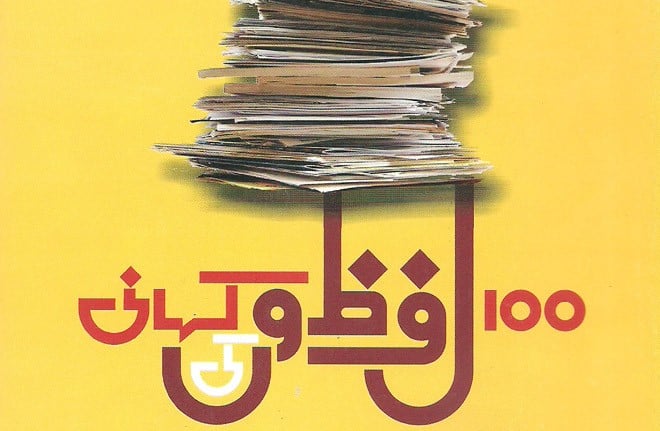
Not only a collection of one hundred mini-stories, but also a short history of the genre and a guide for young writers

When Manto was writing his satirical anecdotes Siyah Haashiay more than sixty years ago, he had no idea that he was in fact trying his hand on a future genre: a format that was to be recognised and labelled as ‘drabble’, some half a century later. Today drabble is a known category of short fiction. It completes the story within 100 words, but it fulfils all technical requirements of a short story: a beginning, a middle and an end. With the increasing popularity of the genre, it has been given various names by the short fiction enthusiasts: flash fiction, hint fiction, sudden fiction, micro fiction and postcard fiction, to name a few.
In the busy world of today, when test matches are converting into one-days, and one-days shrinking to 20/20, the popularity of such a compact genre is understandable. In the UK and USA, people have experimented with this format in many ways: they have tried to minimise the size to 55 or even 50 words. Taking the adventure further ahead, some short fiction mavericks have composed stories within 25 words or even less.
Mini-story is not purely a 21st century phenomenon. The early experiments started in mid-20th century. In 1948, the American author Fredric Brown wrote and published this story: "The last man on earth, sat alone in a room. There was a knock on the door".
Nine years on, Ron Smith changed just one word and created an altogether new perspective: "The last man on earth, sat alone in a room. There was a lock on the door". But the famous novelist Ernest Hemingway beats them all by composing a short story only in six words: "For sale. Baby shoes. Never worn".
These three examples are quoted by Mubashir Ali Zaidi in his new book, 100 Lufzon ki Kahani. It’s not only a collection of his one hundred new mini-stories, but also a short history of the genre, and at the same time a guide for young writers who want to write fiction within the confines of a strict word count.
It may sound contrary to the traditional freedom of an artist, but for Zaidi the restriction of word count is a daily affair. He has been working in the news room of Geo for more than 12 years, and being the bulletin in-charge, he is continuously counting words for each story to be sent on air.
Zaidi is very particular in distinguishing his short fiction from jokes, fables and parables. In structure, a mini-story may resemble a joke: a scene is set, an event takes place, but it ends with an unexpected outcome, which makes the reader laugh. In a mini-story, however, Zaidi insists, the main purpose is not to make you laugh but to surprise you, and incite you to re-evaluate the start and middle of the anecdote with a new understanding.
Towards the end of his book, Zaidi adds a chapter titled, "How to Write a 100-word Story". He invites the young writers to accept this new challenge and gives them some valuable tips to enter the wonderful world of short fiction. "Editing is the key to success," says Mubashir Zaidi. "Drastic and brutal editing of your own work is the only way to master this craft," he insists. He tells us that the best way to write a mini-story is to get rid of our traditional pen and paper, and sit down before a computer. Inpage and Microsoft Word both accommodate Urdu script. While we are writing the story, the software will keep us alert about the word-count.
The last line is always very important in a story and more so in a mini story; the basic purpose however is not to create shock, but to make the reader ponder upon it.
"The first draft," says Zaidi, "is rarely anywhere close to being 100 words and like any [piece of] writing, it’s also very rare that this first version is worth sharing. So, go on abbreviating and reshaping it until you reach the required word count".
This exercise is also useful, we are led to believe, for developing our skills as writers, because the strict word count teaches us how to be economical with our words. Once we have a first draft, we are advised to read through it, if we’re only a dozen or so words out; then it’s a case of picking the right words for the job. If however we are further away from the word count then we need to look at removing whole sentences; in fact we need to remove anything that isn’t core to the story we’re telling.
The book under discussion is the third collection of mini-stories by Mubashir Zaidi, and looking at the speed and consistency of his production -- one story a day for Daily Jang -- one can predict many more collections in the years to come.